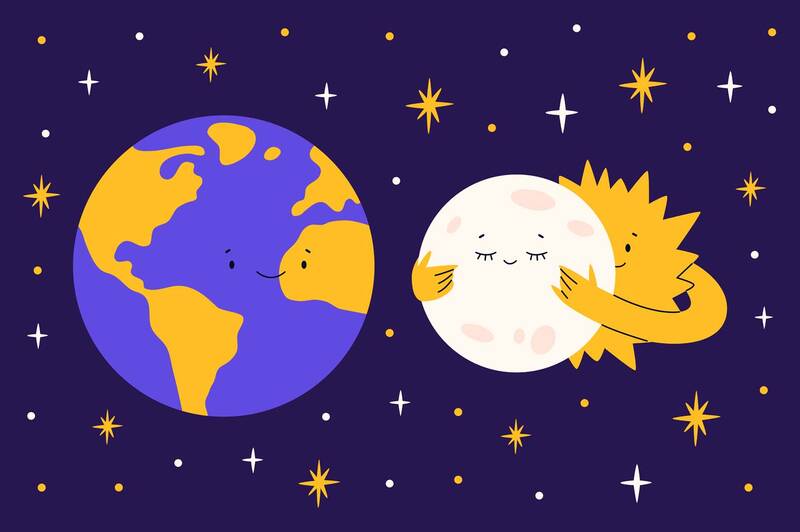The phenomenon known as a solar eclipse occurs when the Moon passes between the Sun and the Earth, and all three directly align. In such a situation, the Moon casts its shadow on the Earth and blocks the Sun. To observers on Earth, the Sun may partially or fully vanish, the sky eerily darkens, and the wind may pick up. In ancient civilizations, these events brought on profound fear and bewilderment. For many centuries and millennia, humans speculated about the reasons for what was happening in the sky above them.
Without scientific knowledge and sophisticated equipment to analyze solar eclipses, our ancestors turned to mythology, folklore, and superstition. Since many ancient cultures worshipped the Sun and the Moon, they created their own stories to explain the temporary darkening of the sky. In ancient China, for example, legend had it that Tiangou, a legendary dog-like creature that was considered an evil spirit, gobbled up the mighty Sun. People would make loud noises by banging on pots, pans, and drums to scare the beast away. Similarly, in Norse culture, it was believed that the Sun was being devoured by a wolf named Skoll, whose brother Hati chased the Moon instead. Like the Chinese, the Norse made a great deal of noise to stop the wolf from feasting upon the Sun. Meanwhile, in some East Asian regions, the explanation for an eclipse was that a giant frog swallowed the solar orb.
While various cultures offer different fantastical reasons for solar eclipses, the event was typically viewed as an omen of impending disaster. These days, people still stand in awe of the celestial occurrence. However, we now understand that we don’t have to fear the Moon blocking the Sun, and we know it is safe to watch the spectacle as long as we are wearing proper eye protection.

Photo: AdobeStock 照片:AdobeStock
被稱為日食的現象在月球穿過太陽和地球之間、三者筆直排成一線時會發生。在這樣的狀況下,月球的影子會投射在地球上,且月球會擋住太陽。對地球上的觀察者來說,太陽可能會部分或完全消失、天空詭異地暗了下來,且風可能會增強。在古文明中,這些事件引起了深刻的恐懼和困惑。數世紀、數千年以來,人們猜測著他們頭頂上的天空發生這樣事件的原因。
我們的祖先沒有科學知識和精密的設備來分析日食,他們轉而向神話、民間傳說和迷信來尋求解答。因為許多古老的文化崇拜太陽和月亮,他們便創造出自己的故事來解釋天空暫時變暗的現象。舉古中國為例,據說天狗 —— 一種傳說中長得像狗的生物,被認為是惡靈 —— 大口吃下了雄偉的太陽。人們會敲打鍋碗瓢盆和鼓來製造巨大的聲響把那隻怪獸嚇跑。同樣地,在北歐文化中,人們認為太陽是被一頭名為斯庫爾的狼所吞食,斯庫爾的兄弟哈提則是追逐著月亮。跟中國人一樣,北歐人也會製造大量的吵鬧聲來阻止那頭狼大啖太陽。同時,在一些東亞地區,日食的解釋是:一隻巨大的青蛙吞下了太陽。
雖然各個文化針對日食提供了不同的奇異解釋,但日食通常被視為即將到來之災難的預兆。如今,人們仍敬畏這個在天空中發生的事件。不過,我們現在知道不必害怕月亮遮擋太陽的現象,且只要穿戴適當的護眼裝備,就能安全地觀賞這個奇觀。
To be continued tomorrow(明日待續)
https://www.taipeitimes.com/News/lang
Words in Use
1. align vi. 排成一線
At the end of the show, the performers aligned and took a bow.
表演結束後,表演者排成一排謝幕。
2. partially adv. 部分地
A car partially blocked the entrance to the restaurant, causing inconvenience.
有一輛車擋住了部分該餐廳的入口,造成不便。
3. vanish vi. 消失
I placed my keys on the table last night, but they somehow vanished this morning.
我昨晚把鑰匙放桌上,但今早不知怎地就消失了。
4. civilization n. 文明
The earliest civilization in history developed in Mesopotamia.
歷史上最早的文明是在美索不達米亞發展的。
5. profound a. 深刻的,深遠的
Childhood experiences can have a profound impact on a person.
童年經歷可能會對一個人造成深遠的影響。
Practical Phrases
1. cast a shadow on... 在……上投下陰影
The candle casts shadows on the wall in the dark room.
蠟燭於昏暗的房內在牆上投下陰影。
2. bring on... 引起∕導致∕帶來……
Steve’s inspiring speech brought on a wave of applause.
史帝夫鼓舞人心的演講讓掌聲群起。
3. legend has it + that 子句 據說……
Legend has it that hidden treasure buried by a pirate lies beneath the old oak tree.
據說一名海盜所埋下的祕寶就在這棵老橡樹下。
4. feast upon / on... 盡情享用……
We feasted upon fresh seafood in the coastal town.
我們在這座沿海小鎮盡情享用了新鮮的海鮮。
5. stand / be in awe of... 敬畏……
awe n. 敬畏,崇敬
Visitors often stand in awe of the ancient architecture of the church.
參觀者常常對這座教堂的古老建築風格感到敬畏。
聽文章朗讀及講解: https://ivy.pse.is/455bfu
本文出自常春藤解析英語雜誌: www.ivy.com.tw

Autism spectrum disorder (ASD) is a neurological and developmental condition marked by disruptions in brain-signaling that causes people to behave, communicate, interact and learn in atypical ways. Autism diagnoses in the US have increased significantly since 2000, intensifying public concern over what might contribute to its prevalence. Here is what you need to know. HOW IS AUTISM DIAGNOSED? There are no objective tools for diagnosing autism, such as blood tests or brain scans. Instead, diagnoses are made based on observations and interviews. The term “spectrum” reflects the wide range of possible manifestations. Some people with ASD might have good conversation skills, while others might

A: When is the Lantern Festival? B: The festival is celebrated on the 15th day of the first month of the lunar calendar, which fell on Feb. 12 this year. A: Oh no! Did I miss the 2025 Taipei Lantern Festival? B: Yes, you did. But you can still go to the 2025 Taiwan Lantern Festival in Taoyuan, which will run until this Sunday. A: Let’s go admire the exuberant lanterns. A: 元宵節到底是哪一天? B: 就是農曆1月15日啊,今年則落在國曆2月12日。 A: 喔不,我是不是錯過了2025台北燈節? B: 是的,但你還可以去桃園的2025台灣燈會,活動將持續至週日。 A: 那我們去欣賞豐富的花燈秀吧! (By Eddy Chang, Taipei Times/台北時報張聖恩)

Every February, the small town of Ptuj in Slovenia comes alive with the vibrant celebration of its famous carnival. This festival, with its deep historical roots, is a cherished tradition where local residents come together to ward off the winter cold and embrace the arrival of spring. Participants dress up in furry costumes, transforming into kurenti, mythical monsters believed to drive away evil spirits and bring good fortune for the new year. Although the exact origins of the Ptuj carnival remain a mystery, it is firmly rooted in ancient Slavic and Illyrian cultures. The modern form of the carnival

A: What’s the theme of the 2025 Taiwan Lantern Festival’s main lantern? B: The theme is “Paradise,” and the main lantern is a snake-shaped “infinity” symbol that features a lighting show every half an hour. A: Cool, I heard that there are over 300 lanterns. B: There are even giant lanterns in the shape of Pikachu and some other popular Pokemon characters. A: Let’s go now. A: 2025台灣燈會主燈的主題是什麼? B: 主題是「無限樂園」!主燈的造型則是蛇形的數學「無限號」,主燈每半小時還有一次燈光秀。 A: 酷喔,聽說總共有300多件花燈作品。 B: 甚至還有皮卡丘和其他熱門寶可夢角色的巨型花燈呢。 A: 哇我們現在就出發吧! (By Eddy Chang, Taipei Times/台北時報張聖恩)